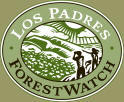|
BIGCONE DOUGLAS-FIR
Pseudotsuga macrocarpa

The bigcone
Douglas-fir is an evergreen conifer found only in the mountains
of southern California, from the San Rafael Mountains in Los
Padres National Forest south to San Diego. It gains its name by
having the largest (by far) cones of all Douglas firs. The
species was discovered in 1858 by an expedition who sighted the
tree in San Felipe canyon near Julian in San Diego County. Early
botanical writers were perplexed by the similarities between the
bigcone and other Douglas firs - the only differences being the
bigcone's extra-large cone size and growth habits.
Bigcone
Douglas-fir is one of twelve "Management Indicator Species" for
the Los Padres National Forest. It was selected for MIS status
because they are believed to be a good indicator of the health
of the ecosystem. They provide habitat for many rare wildlife
species, including the California
spotted owl, which depends on old-growth bigcone
Douglas-firs and other conifers for survival.
Species
Description
 Bigcone
Douglas fir typically grows from 60-100 feet in height with a
2-5 foot trunk diameter and a collection of long branches giving
it a sparse look. One of the largest big cone Douglas-fir trees
on the Los Padres is located near Antimony Peak in Kern County,
and measures more than 7 feet in diameter! Bigcone
Douglas fir typically grows from 60-100 feet in height with a
2-5 foot trunk diameter and a collection of long branches giving
it a sparse look. One of the largest big cone Douglas-fir trees
on the Los Padres is located near Antimony Peak in Kern County,
and measures more than 7 feet in diameter!
Cones are
from 4-7 inches long (see photo, comparing the much larger cone
of the bigcone Douglas-fir with the smaller Douglas-fir cone),
with larger, thicker scales than those of other Douglas firs.
The seeds are actually so large and heavy that they are probably
bird or mammal dispersed as the wing is too small to be
effective for wind dispersal. Trees start producing seeds at
about 20 years of age, and can live to be hundreds of years old
(the oldest recorded bigcone Douglas fir was over 600 years
old!).
Range
 The
range of the bigcone Douglas fir is about 135 miles from north
to south and about 210 miles from east to west. Northern limits
are near Mount Pinos in Kern County, and the headwaters of La
Brea Creek in Santa Barbara County. Westernmost limits are
Mission Canyon in the Santa Ynez Mountains, and Zaca Peak in the
San Rafael Mountains. Older publications claimed that bigcone
Douglas fir grew in central Baja California, Mexico; a more
recent publication verifies that it does not. The southern limit
of the species is near the small mountain town of Julian, in San
Diego County. The trees can grow under a wide variety of
conditions: from under 1,000 feet elevation to over 8,000 feet,
and chooses different orientation and 'neighbor species'
depending on altitudinal conditions and climatic influences. The
range of the bigcone Douglas fir is about 135 miles from north
to south and about 210 miles from east to west. Northern limits
are near Mount Pinos in Kern County, and the headwaters of La
Brea Creek in Santa Barbara County. Westernmost limits are
Mission Canyon in the Santa Ynez Mountains, and Zaca Peak in the
San Rafael Mountains. Older publications claimed that bigcone
Douglas fir grew in central Baja California, Mexico; a more
recent publication verifies that it does not. The southern limit
of the species is near the small mountain town of Julian, in San
Diego County. The trees can grow under a wide variety of
conditions: from under 1,000 feet elevation to over 8,000 feet,
and chooses different orientation and 'neighbor species'
depending on altitudinal conditions and climatic influences.
Bigcones &
Wildfire
 Bigcone
Douglas is one of the most fire resistant and fire adapted
conifers in the world, beat only by redwoods in its ability to
recover from fire. Its thick bark and the presence of numerous
buds on the upper side of the branches aid in its resistance -
the trees will sprout from the burnt upper crown and the
apparently dead tree becomes green again the following spring!
Bigcones are also usually free from bark beetle attacks
post-fire. Bigcone
Douglas is one of the most fire resistant and fire adapted
conifers in the world, beat only by redwoods in its ability to
recover from fire. Its thick bark and the presence of numerous
buds on the upper side of the branches aid in its resistance -
the trees will sprout from the burnt upper crown and the
apparently dead tree becomes green again the following spring!
Bigcones are also usually free from bark beetle attacks
post-fire.
These adaptations suggest that the species has evolved to
survive multiple fire events that sweep through these stands
from the surrounding chaparral. A
2009 study conducted in
the Los Padres National Forest looked at tree rings and fire
scars on 85 bigcone Douglas-firs at 15 different sites. The
earliest fire scars detected dated back to the year 1600,
allowing scientists to reconstruct four centuries of fire
history. The results indicated evidence of fire every 23-45
years in bigcone Douglas-fir ecosystems.
|

